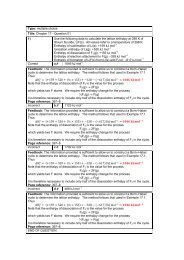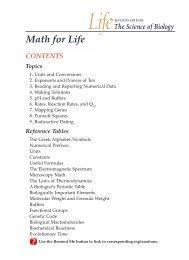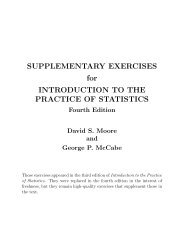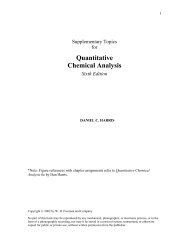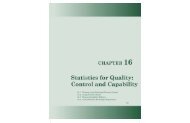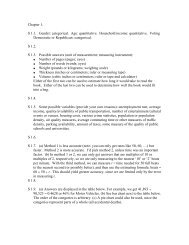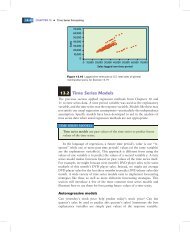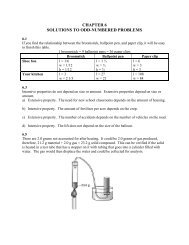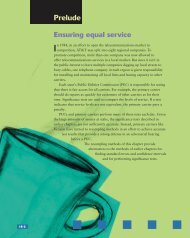Chapter 3 - Experimental Error - WH Freeman
Chapter 3 - Experimental Error - WH Freeman
Chapter 3 - Experimental Error - WH Freeman
You also want an ePaper? Increase the reach of your titles
YUMPU automatically turns print PDFs into web optimized ePapers that Google loves.
46<br />
3 <strong>Experimental</strong> <strong>Error</strong><br />
Significant figures: minimum number<br />
of digits required to express a value in<br />
scientific notation without loss of<br />
accuracy<br />
Significant zeros below are bold:<br />
106 0.010 6 0.106 0.106 0<br />
Interpolation: Estimate all readings to<br />
the nearest tenth of the distance<br />
between scale divisions.<br />
0.002 g and 0.05 mL, but what is the uncertainty in the computed density? And how<br />
many significant figures should be used for the density? This chapter discusses the<br />
propagation of uncertainty in lab calculations.<br />
3-1 Significant Figures<br />
The number of significant figures is the minimum number of digits needed to write a<br />
given value in scientific notation without loss of accuracy. The number 142.7 has four<br />
significant figures, because it can be written 1.427 10 2 . If you write 1.427 0 10 2 ,<br />
you imply that you know the value of the digit after 7, which is not the case for the<br />
number 142.7. The number 1.427 0 10 2 has five significant figures.<br />
The number 6.302 10 6 has four significant figures, because all four digits are<br />
necessary. You could write the same number as 0.000 006 302, which also has just four<br />
significant figures. The zeros to the left of the 6 are merely holding decimal places. The<br />
number 92 500 is ambiguous. It could mean any of the following:<br />
9.25 10 4 3 significant figures<br />
9.250 10 4 4 significant figures<br />
9.250 0 10 4 5 significant figures<br />
You should write one of the three numbers above, instead of 92 500, to indicate how<br />
many figures are actually known.<br />
Zeros are significant when they occur (1) in the middle of a number or (2) at the<br />
end of a number on the right-hand side of a decimal point.<br />
The last significant digit (farthest to the right) in a measured quantity always has<br />
some associated uncertainty. The minimum uncertainty is 1 in the last digit. The scale<br />
of a Spectronic 20 spectrophotometer is drawn in Figure 3-1. The needle in the figure<br />
appears to be at an absorbance value of 0.234. We say that this number has three significant<br />
figures because the numbers 2 and 3 are completely certain and the number 4 is an<br />
estimate. The value might be read 0.233 or 0.235 by other people. The percent transmittance<br />
is near 58.3. Because the transmittance scale is smaller than the absorbance<br />
scale at this point, there is more uncertainty in the last digit of transmittance. A reasonable<br />
estimate of uncertainty might be 58.3 0.2. There are three significant figures in<br />
the number 58.3.<br />
When reading the scale of any apparatus, try to estimate to the nearest tenth of<br />
a division. On a 50-mL buret, which is graduated to 0.1 mL, read the level to the<br />
nearest 0.01 mL. For a ruler calibrated in millimeters, estimate distances to the nearest<br />
0.1 mm.<br />
There is uncertainty in any measured quantity, even if the measuring instrument<br />
has a digital readout that does not fluctuate. When a digital pH meter indicates a pH of<br />
3.51, there is uncertainty in the digit 1 (and maybe even in the digit 5). By contrast,<br />
some numbers are exact—with an infinite number of unwritten significant digits. To<br />
calculate the average height of four people, you would divide the sum of heights (which<br />
is a measured quantity with some uncertainty) by the integer 4. There are exactly 4 people,<br />
not 4.000 0.002 people!<br />
Percent transmittance<br />
0 10 20 30 40 50<br />
60 70 80 90 100<br />
Figure 3-1<br />
Scale of a Bausch and<br />
Lomb Spectronic 20 spectrophotometer.<br />
Percent transmittance is a linear scale<br />
and absorbance is a logarithmic scale.<br />
• 2 1.0 0.5 0.4 0.3 0.2 0.1 0.05 0<br />
Absorbance





